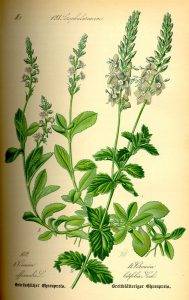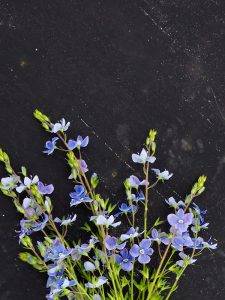
Medicinal veronica – Veronica officinalis L.
Description of Medical Veronica:
Veronica officinalis L. (Old or other familiar names: veronica, veronica, glory-grass, sweet-grass, wood sage, medicinal sage, harpwort, harpicaceous sage, sickle-grass) Medical veronica is a perennial plant. It has a rounded stem with coarse hairs evenly distributed around the circumference of the stem. The stem is 15-30 cm tall, the base is tapering. Leaves are transverse, short-tongued, oblong-ovate, serrate-edged, greyish green and hairy on both leaves. Flowers are in axillary clusters in the axils of the leaves, forming a dense, compact raceme. The flowers are short-tongued, small, light blue at first with dark white-red veins, but flattening as they dry. The flower has a four-parted green calyx, which remains after the pistil has fallen off; the pistil is in one piece, easily falling off, rounded, the lower part forming a short tube, the flange being cut into four unequal lobes, the upper one larger than the other three. The pair has two stamens. Veronica flowers in June and July.
Veronica occurrence:
Medicinal veronica is native to mountain forests throughout the country, found mostly in dry, grassy places in mountain pastures, along the edges of forests and shrublands, and along streams. It can also reach up into the snowy mountains.
Medicinal properties and uses of medicinal veronica:
Medical veronica contains a knife-like and tannic substance, for the sake of which it has become a medicinal plant, but is now regarded as a harmless basal substance with no other half of its active ingredients. However, herbalists still buy veronica, picked in flower and dried, which is known in the trade asherba veronicae , albeit in limited quantities. The leaves of veronica were used as a tea for the treatment of breast ulcers and cystic ailments, as well as for the treatment of wounds and for the prevention of mucous congestion of the respiratory organs. As a medicine, it has been used as an ingredient in various tea mixtures. Russian tea was also in wide demand as a tea poultice because of its pleasant aroma.
 Active ingredient:
Active ingredient:
Bitter and tannic acid.
Uses:
To be harvested when the medicinal veronica is in flower (the above ground part of the plant flowering between May and July). The leaves of the harvested plants should be stripped of the stem and carefully ploughed in the attic to retain their green colour, 4 kg of fresh leaves will yield 1 kg of dry leaves. Source: Dr. Ferenc Darvas and Dr. Gyula Magyary-Kossa,Domestic herbs, their production, marketing, effects and medicinal uses Béla Páter, Wild medicinal plants, their production, use, distribution, and marketing
